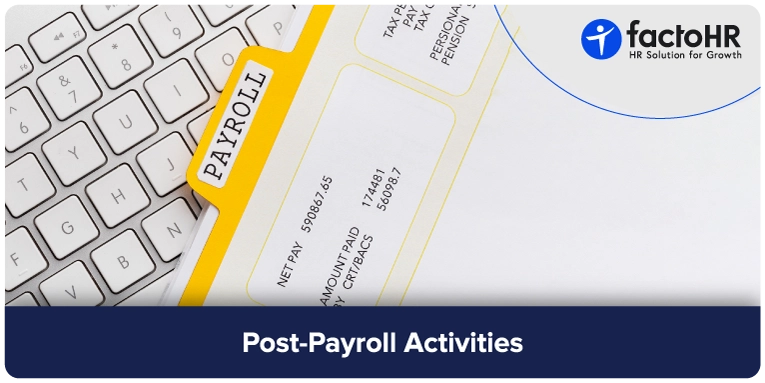Post-Payroll Activities: A Detailed Overview

Table of Contents
Payroll processing involves a series of tasks within a company. Employee salaries and other expenses have a big impact on the work culture when running a business. An accurate payroll management software shows that the company’s processes run smoothly and efficiently. Employees are considered the most significant assets of any firm. Therefore, administering payroll processing in an error-free manner is vital.
The term Post-Payroll Activities includes gathering and compiling payroll information, deducting taxes, and sending them to the appropriate government agencies.
What is the Indian Payroll Process?
The process of paying employees, known as payroll processing, involves several steps. These steps include pre-payroll activities, actual payroll processing, and post-payroll activities. Employees receive their wages through checks or direct deposit.
The Indian payroll process is critical since it entails calculating employees’ ‘net salary’ or net pay after making appropriate changes per the company’s rules and statutory compliances.
Payroll calculation in India is more complex than it appears. When calculating employee salary, numerous variables must be considered. They are as follows:
- CTC Gross Salary
- Net Salary Allowances
- Prerequisites
- Form 16
- Payslip Deductions
- Reimbursements
- Ad hoc components.
- Bonuses, incentives, expenses, and one-time payments.
- Bank Account Information for the Company
- Signatory Details
- Company’s required details (like PAN, TAN, PT, ESI, PF, and LWF if applicable)
- Employee Investment Declarations
- Employee Financial Details
- Previous Salary Details:
- Annual CTC/Gross for all workers.
All employers must consider these compliances when deducting them from employees’ salaries. Using a CTC calculator is advisable to calculate employees’ CTCs. Most organizations use tools and software to make it easy.

What are the Post-Payroll Activities?
After paying employees, it is important to complete tasks to comply with the law, handle professional tax, accurately report finances, and maintain good records. These tasks are known as post-payroll activities.
Post-Payroll Process
The post payroll processes are a set of post payroll activities followed chronologically by the organizations. The following are the steps of the process:
Statutory Compliance
All deductions, including TDS and EPF, are deducted during payroll processing. Subsequently, the entire amount of this deduction is sent to government agencies, where it is repaid or reported as part of the PF return filing process.
Payroll Accounting
Each corporation keeps a record of all financial transactions. Similarly, the salary transaction is added to the account’s books. This is part of the payroll administration system, which ensures that all salary data is entered correctly into the accounting system.
Payout
Companies pay employees through bank transfers, cheques, or cash. Before making the payment, the company needs to ensure that there is enough money in its bank account. The amount paid to employees is not the same as their basic salary because various taxes are deducted from it.
The salary statement, including the employee’s ID, the amount to be paid, and the account number, is then taken to the bank branch. Some companies use a automated system that allows employees to access their pay stubs online, making it convenient for them to receive their paychecks.
Reporting
A report with all the data from each pay period is generated after each pay period. The payroll officer is responsible for maintaining the department-specific reporting system and providing access to it when needed.

What is a Payroll Management System?
Using an automated payroll management system is crucial in today’s advancing technology. Around 33% of companies agree that implementing automated system can simplify payroll calculations.
A good system helps in processing payroll efficiently and accurately, ensuring that the organization’s payroll administration system remains regulated. Consider using FactoHR software, which offers the following features:
User-friendly Interface
The payroll system should be user-friendly and uncomplicated. It will lessen the amount of training required to utilize the software. Furthermore, the program should be supported by appropriate documentation so that you can access all of the information.
Data Analysis
Dashboards, graphs, and reports to examine pay data and gain insights into your employees. These insights contribute to your organization’s workforce planning initiatives.
Versatility
The program should be scalable enough to manage the growing number of employees. It should have a payment model, an attendance and leave management system, and the ability to upgrade to higher capabilities simply.
Audits
This is a valuable feature. Some solutions allow you to put up pre-submit audit flags that inform you when something appears unusual, such as someone receiving much more than their customary compensation.
Employee Self-Service Login
This feature is very important for any system. It provides information such as the tax-saving choices made by the employee, the flexible benefits used by the employee, and more. This makes it easier for employees to talk to the payroll officer.
Financial Management Tools
Financial management is vital. This is why some software solutions include tools that help employees save money and better manage their finances. Leading to saving money and good finance management.
Customizable payroll reports
Personalizing your payroll records to track taxes, employee deductions, and additional expenses can aid in budgeting and financial planning.
How is Payroll Management done in Organizations?
The payroll process sends employee pay to their accounts. The software makes the process easier and helps businesses manage wages with cloud-based technology. It automates complex tasks, works with HR management software, and offers a complete solution for payroll and HR responsibilities that can be accessed from any device. HR management is important for every organization because it ensures employee well-being and access to resources.
Conclusion
Thus, even though payroll processing in India can be challenging, it is pivotal for enterprises to pay employees the correct amount of their wages or salaries while referring to the legal requirements and standards. This guide will help companies enhance efficiency and reap many advantages by following the steps of a payroll processing procedure.

Frequently Asked Questions
What is the meaning of Payroll Policy?
A payroll policy explains how an organization handles employee pay, including salary calculations, timesheets, payment schedules, methods, processing services, legal requirements, and worker status.
What exactly is meant by the Payroll Calculation?
Payroll computation involves entering all of your employees’ information into the system after making the necessary deductions required by government regulations. This calculation and process lead to the release of net pay to an employee’s account or the issue of paychecks.
What constitutes the Post Payroll Phase?
The majority of the post payroll procedure consists of paying your employees’ salaries. Once the payroll computation is finished, send the bank advice to your business bank for salary payout.
What are the Payouts in Payroll Activities?
Payout in payroll activities means transferring or paying employees’ salaries. Furthermore, ensure your account has sufficient funds to cover your employees’ pay and costs.
Grow your business with factoHR today
Focus on the significant decision-making tasks, transfer all your common repetitive HR tasks to factoHR and see the things falling into their place.

© 2025 Copyright factoHR


